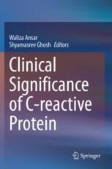Search
Search Results
-
Association of mTOR Pathway and Conformational Alterations in C-Reactive Protein in Neurodegenerative Diseases and Infections
Inflammatory biomarkers have been very useful in detecting and monitoring inflammatory processes along with providing helpful information to select...

-
Intra-subunit Disulfide Determines the Conversion and Structural Stability of CRP Isoforms
C-reactive protein (CRP) is a major human acute-phase reactant that is composed of five identical subunits. CRP dissociates into subunits at...

-
Role of SNP in CRP and Biology of Cancer
C-reactive protein (CRP) has gained significant traction in the medical world due to the discovery of its role in identifying and categorizing...
-
Multiple Faces of C-Reactive Protein: Structure–Function Relationships
C-reactive protein (CRP) is a fascinating acute phase protein which plays a range of functions in different physiological or pathophysiological...
-
Role of CRP in Monitoring of Acute Pancreatitis
Acute pancreatitis (AP) is an inflammatory disorder of the pancreas secondary to activation of its own enzymes, which can lead to local and systemic...
-
Regulation of C-reactive protein conformation in inflammation
C-reactive protein (CRP) is a non-specific diagnostic marker of inflammation and an evolutionarily conserved protein with roles in innate immune...

-
C-Reactive Protein and Neurodegenerative Diseases
Inflammatory biomarkers are a very useful tool used to detect and monitor inflammatory processes and in the selection of the therapy strategy to use....
-
C-Reactive Protein in Inflammatory Bowel Disease
Crohn’s disease (CD) and ulcerative colitis (UC) are the two main forms of inflammatory bowel disease (IBD) which are characterized by chronic...
-
The eye as a complement dysregulation hotspot
Complement turnover is tightly regulated throughout the human body in order to prevent over-activation and subsequent damage from inflammation. In...

-
C-reactive protein enhances activation of coagulation system and inflammatory response through dissociating into monomeric form in antineutrophil cytoplasmic antibody-associated vasculitis
BackgroundC-reactive protein (CRP) exerts prothrombotic effects through dissociating from pentameric CRP (pCRP) into modified or monomeric CRP...

-
C-Reactive Protein: A Clinical Marker in Cardiovascular Disease
Atherosclerotic vascular disease reveals the process of inflammation including several key mediators and markers of inflammation as major...
-
Inflammation-Associated Co-morbidity Between Depression and Cardiovascular Disease
Morbidity and mortality of cardiovascular disease (CVD) is exceedingly high worldwide. Depressive illness is a serious psychiatric illness that...
-
Defective Complement Action and Control Defines Disease Pathology for Retinal and Renal Disorders and Provides a Basis for New Therapeutic Approaches
The complement system is a central homeostatic system of the vertebrate organism and part of innate immunity. When activated, complement has multiple...
-
Pathway analysis in blood cells of pigs infected with classical swine fever virus: comparison of pigs that develop a chronic form of infection or recover
Infection of pigs with CSFV can lead to either acute disease, resulting in death or recovery, or chronic disease. The mechanisms by which CSFV...

-
Treponema denticola: FhbB, Dentilisin, Complement Evasion and the Paradox of Factor H Cleavage
Treponema denticola transitions from being relatively low in number in the sub-gingival crevice of healthy individuals to being...
-
Protective molecules and their cognate antibodies: new players in autoimmunity
Impairment of the clearance of apoptotic material seems to contribute to autoantigen exposure, which can initiate or maintain an autoimmune response...
-
Inefficient clearance of dying cells in patients with SLE: anti-dsDNA autoantibodies, MFG-E8, HMGB-1 and other players
Systemic lupus erythematosus (SLE) is a complex disease resulting from inflammatory responses of the immune system against several autoantigens....

-
CRP and the risk of atherosclerotic events
A large body of literature supports the idea that inflammation plays a pivotal role in all phases of atherosclerosis, from the fatty streak lesion...

